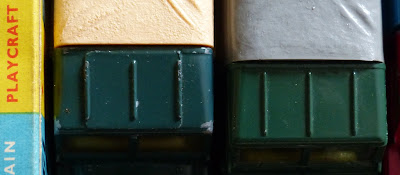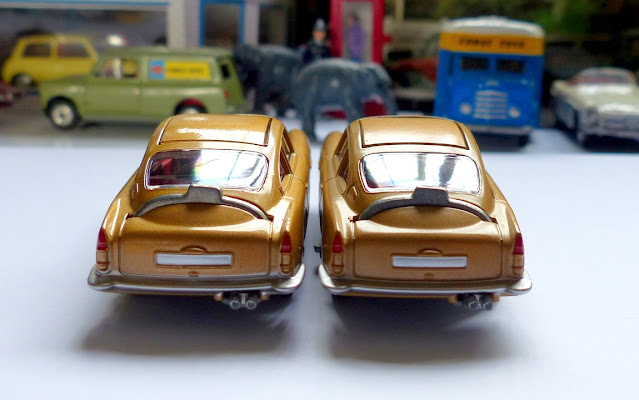Updated 15 May with new information
Professor Cary Nederman from Texas A&M University has sent me these three models. He bought them some years ago at an auction and, for some reason, has been staring at them recently and wondering just what they are. In desperation, he turned to me and wrote at length about them but without images. I suggested that it was unlikely that they would be Corgi factory prototypes but the Professor was determined to find out and, without further ado, dispatched them at great cost via UPS to my address here in a small village in Northamptonshire, where they arrived earlier today.
I decided to publish my comments on these items as they may give some assistance to others who think they have something original which may not be.
The first item is this white 303S Mercedes-Benz 300SL Roadster. It looks attractive in white with a red interior with the smooth but free-spinning wheels only to be found on this model.
It's missing a stripe but then early models with suspension didn't have the stripe so it sounded like an interesting item worthy of closer inspection.
Unfortunately, there are three things which make this something someone has created at some later date.
The rivet is usually the first thing to look at. Here you can see it is shiny and quite new-looking, and not really like any of the type of head that you will see on this model. It looks to me like one of a type that you can buy in packs of 100 from a replacement parts seller. I haven't tried but I suspect that a sharp knock horizontally might even dislodge it as these are usually glued in place.
The second is the overpaint of silver on the base. That's a sure-fire sign of something being amiss, although you also need to accept that someone may just have tried to touch up some paint on an otherwise original model.
The third sign, though, is more definite and shows some rather poor preparation of the original seating until before the red was applied. Not good and, coupled with the rivets, I was quite disappointed with the chap's work, whoever it might have been.
Next we have the almost famous Citroën hearse.
It looks fairly reasonable at first glance.
The rear window looked a bit odd to me and I thought it was a replacement. When it arrived there was what I had thought was glue around it too but, after cleaning, it does seem OK after all and this image just catches it at a bad angle. Of more concern, though, was the distinctly unclear windows pretty much all round. This strikes me as either a poor replacement or, more likely, someone has tried to clean an old unit and not used the best of solvents. Not obvious in these photos but the rear side window on one side is not well-fitted either, leaving a gap at the top I have never recalled noticing on any other of these models.
So my suspicions are aroused quite quickly. The finish on the paintwork is reasonable but the red paint has been added in a different design to that on the factory prototype. That has three distinct blobs of paint on the rear light section. This has the whole sections painted red.
Furthermore, the driver is a uniformed character which I believe I have seen in the early editions of the London Transport Gift Set taxi. My understanding is that the factory prototype had another character, not this one. I have not got a good copy of any image, however, so I am not sure about that. Hopefully someone will advise further, please.
There is also no coffin, although I can accept that it may have slid out and away into some box never to be seen again. This, however, is another fairly amateur production and I suspect that the creation of a suitable copy of the coffin was beyond the skills of this model builder, judging by his standards of window fitting and cleaning.
and, of course, we only have to turn it over and see the silly rivet heads anyway!
Nice grey paintwork on the base, though. Credit where credit is due. Below may be a picture of the actual prototype. I am not totally sure of its provenance, though.
Now for the star of the show. Page 77 of The Great Book Of Corgi has an illustration of the prototype that the factory made in 1959 of a 'Playcraft Promotion' van.
This looks great, from all angles.
The paintwork is very well-done and it has a much more professional air about it than the previous two. My suspicions have already been aroused, though, by them so, if they all came from the same source then it is highly likely that this, too, will be a Code 3 production by someone sometime. I need to gather some evidence, however.
I'll start with the tyres.
They are new replacements from a parts supplier that I have used before myself. Annoyingly, they come with those tiny bits of rubber attached to the tread. No factory production would have had these. However, we must allow for the fact that someone may have simply replaced them on an original model. So what else can I find?
Let's look at the base.
This time there are no rivets, just the twisted spurs which were used on a few models - notably the Ecurie Ecosse Transporter. One would have expected to see some damaged to the grey or blue paint had these been twisted to seal the base after fitting. I can only detect the feintest of marks. The grey paint is excellent but then it was excellent on the Citroën too.
So I need more evidence about this one.
After a lot of searching I found some that had been sold by QDT and Vectis.
The QDT one made £100 and was described as a good copy of the prototype but with a different illustration in the window. Unfortunately for the Professor, his has the same illustration! His also has some display in the rear window, however, missing from the QDT illustration. There are also differences in the rear light painting, his having none, probably more accurate than the red and orange of this one, which would have been unlikely in 1959 when the prototype was said to have been made.
Above we have two of the Vectis offerings. These both have text along the red stripe at the side and each has a different display in the windows with nothing at the rear. You really would have expected people who go to the trouble of getting the paint right and lettering, transfers positioned well and all that to get the displays right! Painting three, sorry, four colours this accurately would not have been easy.
Finally, there is another problem with the Professors' edition. The wheels, not to mention suspension. His is a 426 Chipperfields Booking Office that has been revised. All the other copies of the prototype have been 407 Mobile Shops. If the prototype was supposedly envisaged and made in 1959, as QDT say the book says, then the 1962 Booking Office would not have been available. Nor would shaped wheels. Or suspension. Sadly, therefore, despite looking rather better on display than any of the copies I have found, it's wrong on at least three counts.
Update 15 May:
I contacted the person who bought my copy of the Great Book of Corgi (2nd Edition) and this has been most valuable. Firstly, the illustration.
It is immediately obvious that neither the QDT nor Vectis auction items were really anything more than rather poor efforts and I was wrong about the 407 being used as a base for the prototype. It just goes to show that you simply cannot rely upon the comments by even the auctioneers who specialise in Corgis! To be fair, Vectis did only sell their copy for £15 but QDT appear to have convinced someone to part with £100 plus not insubstantial fees for something which was quite wrong!
So we can see that the prototype illustrated by Marcel Van Cleemput was, indeed, based on a 426 Chipperfields Booking Office and it appears to have free-spinning wheels, unusual for that model and this was certainly made rather later than 1959. It would appear that people have been confused by the reference to 1959 as when the Display Van was first used at places like Silverstone Race Course (where, coincidentally, my contact for the book had been in charge of the place and may well have agreed to the Corgi promotion there too!) The construction of that prototype would have been somewhat later and that means that the Professor's model is much more accurate than I had appreciated.
It doesn't need the lettering on the red strip and the colours are accurate. Yes, the wheels are still not right but they're close enough for the copy to have some value. We can see that the window display is not correct but none of them have been. So, yes, it is wrong on a few counts but not as badly wrong as I had first envisaged.
So I am going to have to report that these are all copies, made by someone with some skill, certainly in the case of the Karrier Van, rather less so in the case of the Hearse. In this instance I believe the Professor agreed that I would be free to do what I wished with each of the models as he would not want them back and the cost of return, even at the rather more modest method I would employ, would be pretty much equal to the value of two of them. So, once I have finally concluded this bit of investigation, I may have these available for sale. The Karrier does look good, albeit with the slightly wrong wheels, and the Mercedes is an interesting item to add to a collection of those models. The Hearse will always attract attention too if someone cares to put it on their shelf one day.
In the meantime, if anyone has some good pictures of what the other actual prototypes looked like, do let me know. It would be helpful when I reply to break the news to my colleague.
Another update: from someone who knows about these things:
The top model was first reproduced by a very well know restoration specialist here in Sussex, Alan Morris. He did less than 10 examples and they are very nicely done. The colours of his examples are very true to the original, but the pictures inside of course aren’t the same as the original prototype. I’ve sold two over the years (not mine, it’s in the Museum on display) and they fetched £75-100 each, so there are collectors willing to pay for unusual examples of unissued models.





























































.jpg)